The Princeton Companion to Mathematics
Contents
Preface
Contributors
Part I Introduction
I.1 What Is Mathematics About?
I.2 The Language and Grammar of Mathematics
I.3 Some Fundamental Mathematical Definitions
I.4 The General Goals of Mathematical Research
Part II The Origins of Modern Mathematics
II.1 From Numbers to Number Systems
II.2 Geometry
II.3 The Development of Abstract Algebra
II.4 Algorithms
II.5 The Development of Rigor in Mathematical Analysis
II.6 The Development of the Idea of Proof
II.7 The Crisis in the Foundations of Mathematics
Part III Mathematical Concepts
III.1 The Axiom of Choice
III.2 The Axiom of Determinacy
III.3 Bayesian Analysis
III.4 Braid Groups
III.5 Buildings
III.6 Calabi–Yau Manifolds
III.7 Cardinals
III.8 Categories
III.9 Compactness and Compactification
III.10 Computational Complexity Classes
III.11 Countable and Uncountable Sets
III.12 C*-Algebras
III.13 Curvature
III.14 Designs
III.15 Determinants
III.16 Differential Forms and Integration
III.17 Dimension
III.18 Distributions
III.19 Duality
III.20 Dynamical Systems and Chaos
III.21 Elliptic Curves
III.22 The Euclidean Algorithm and Continued Fractions
III.23 The Euler and Navier–Stokes Equations
III.24 Expanders
III.25 The Exponential and Logarithmic Functions
III.26 The Fast Fourier Transform
III.27 The Fourier Transform
III.28 Fuchsian Groups
III.29 Function Spaces
III.30 Galois Groups
III.31 The Gamma Function
III.32 Generating Functions
III.33 Genus
III.34 Graphs
III.35 Hamiltonians
III.36 The Heat Equation
III.37 Hilbert Spaces
III.38 Homology and Cohomology
III.39 Homotopy Groups
III.40 The Ideal Class Group
III.41 Irrational and Transcendental Numbers
III.42 The Ising Model
III.43 Jordan Normal Form
III.44 Knot Polynomials
III.45 K-Theory
III.46 The Leech Lattice
III.47 L-Functions
III.48 Lie Theory
III.49 Linear and Nonlinear Waves and Solitons
III.50 Linear Operators and Their Properties
III.51 Local and Global in Number Theory
III.52 The Mandelbrot Set
III.53 Manifolds
III.54 Matroids
III.55 Measures
III.56 Metric Spaces
III.57 Models of Set Theory
III.58 Modular Arithmetic
III.59 Modular Forms
III.60 Moduli Spaces
III.61 The Monster Group
III.62 Normed Spaces and Banach Spaces
III.63 Number Fields
III.64 Optimization and Lagrange Multipliers
III.65 Orbifolds
III.66 Ordinals
III.67 The Peano Axioms
III.68 Permutation Groups
III.69 Phase Transitions
III.70 π
III.71 Probability Distributions
III.72 Projective Space
III.73 Quadratic Forms
III.74 Quantum Computation
III.75 Quantum Groups
III.76 Quaternions, Octonions, and Normed Division Algebras
III.77 Representations
III.78 Ricci Flow
III.79 Riemann Surfaces
III.80 The Riemann Zeta Function
III.81 Rings, Ideals, and Modules
III.82 Schemes
III.83 The Schrödinger Equation
III.84 The Simplex Algorithm
III.85 Special Functions
III.86 The Spectrum
III.87 Spherical Harmonics
III.88 Symplectic Manifolds
III.89 Tensor Products
III.90 Topological Spaces
III.91 Transforms
III.92 Trigonometric Functions
III.93 Universal Covers
III.94 Variational Methods
III.95 Varieties
III.96 Vector Bundles
III.97 Von Neumann Algebras
III.98 Wavelets
III.99 The Zermelo–Fraenkel Axioms
Part IV Branches of Mathematics
IV.1 Algebraic Numbers
IV.2 Analytic Number Theory
IV.3 Computational Number Theory
IV.4 Algebraic Geometry
IV.5 Arithmetic Geometry
IV.6 Algebraic Topology
IV.7 Differential Topology
IV.8 Moduli Spaces
IV.9 Representation Theory
IV.10 Geometric and Combinatorial Group Theory
IV.11 Harmonic Analysis
IV.12 Partial Differential Equations
IV.13 General Relativity and the Einstein Equations
IV.14 Dynamics
IV.15 Operator Algebras
IV.16 Mirror Symmetry
IV.17 Vertex Operator Algebras
IV.18 Enumerative and Algebraic Combinatorics
IV.19 Extremal and Probabilistic Combinatorics
IV.20 Computational Complexity
IV.21 Numerical Analysis
IV.22 Set Theory
IV.23 Logic and Model Theory
IV.24 Stochastic Processes
IV.25 Probabilistic Models of Critical Phenomena
IV.26 High-Dimensional Geometry and Its Probabilistic Analogues
Part V Theorems and Problems
V.1 The ABC Conjecture
V.2 The Atiyah–Singer Index Theorem
V.3 The Banach–Tarski Paradox
V.4 The Birch–Swinnerton-Dyer Conjecture
V.5 Carleson’s Theorem
V.6 The Central Limit Theorem
V.7 The Classification of Finite Simple Groups
V.8 Dirichlet’s Theorem
V.9 Ergodic Theorems
V.10 Fermat’s Last Theorem
V.11 Fixed Point Theorems
V.12 The Four-Color Theorem
V.13 The Fundamental Theorem of Algebra
V.14 The Fundamental Theorem of Arithmetic
V.15 Gödel’s Theorem
V.16 Gromov’s Polynomial-Growth Theorem
V.17 Hilbert’s Nullstellensatz
V.18 The Independence of the Continuum Hypothesis
V.19 Inequalities
V.20 The Insolubility of the Halting Problem
V.21 The Insolubility of the Quintic
V.22 Liouville’s Theorem and Roth’s Theorem
V.23 Mostow’s Strong Rigidity Theorem
V.24 The P versus NP Problem
V.25 The Poincaré Conjecture
V.26 The Prime Number Theorem and the Riemann Hypothesis
V.27 Problems and Results in Additive Number Theory
V.28 From Quadratic Reciprocity to Class Field Theory
V.29 Rational Points on Curves and the Mordell Conjecture
V.30 The Resolution of Singularities
V.31 The Riemann–Roch Theorem
V.32 The Robertson–Seymour Theorem
V.33 The Three-Body Problem
V.34 The Uniformization Theorem
V.35 The Weil Conjectures
Part VI Mathematicians
VI.1 Pythagoras (ca. 569 b.c.e.–ca. 494 b.c.e.)
VI.2 Euclid (ca. 325 b.c.e.–ca. 265 b.c.e.)
VI.3 Archimedes (ca. 287 b.c.e.–212 b.c.e.)
VI.4 Apollonius (ca. 262 b.c.e.–ca. 190 b.c.e.)
VI.5 Abu Ja’far Muhammad ibn Mūsā al-Khwārizmī (800–847)
VI.6 Leonardo of Pisa (known as Fibonacci) (ca. 1170–ca. 1250)
VI.7 Girolamo Cardano (1501–1576)
VI.8 Rafael Bombelli (1526–after 1572)
VI.9 François Viète (1540–1603)
VI.10 Simon Stevin (1548–1620)
VI.11 René Descartes (1596–1650)
VI.12 Pierre Fermat (160?–1665)
VI.13 Blaise Pascal (1623–1662)
VI.14 Isaac Newton (1642–1727)
VI.15 Gottfried Wilhelm Leibniz (1646–1716)
VI.16 Brook Taylor (1685–1731)
VI.17 Christian Goldbach (1690–1764)
VI.18 The Bernoullis (.. 18th century)
VI.19 Leonhard Euler (1707–1783)
VI.20 Jean Le Rond d’Alembert (1717–1783)
VI.21 Edward Waring (ca. 1735–1798)
VI.22 Joseph Louis Lagrange (1736–1813)
VI.23 Pierre-Simon Laplace (1749–1827)
VI.24 Adrien-Marie Legendre (1752–1833)
VI.25 Jean-Baptiste Joseph Fourier (1768–1830)
VI.26 Carl Friedrich Gauss (1777–1855)
VI.27 Siméon-Denis Poisson (1781–1840)
VI.28 Bernard Bolzano (1781–1848)
VI.29 Augustin-Louis Cauchy (1789–1857)
VI.30 August Ferdinand Möbius (1790–1868)
VI.31 Nicolai Ivanovich Lobachevskii (1792–1856)
VI.32 George Green (1793–1841)
VI.33 Niels Henrik Abel (1802–1829)
VI.34 János Bolyai (1802–1860)
VI.35 Carl Gustav Jacob Jacobi (1804–1851)
VI.36 Peter Gustav Lejeune Dirichlet (1805–1859)
VI.37 William Rowan Hamilton (1805–1865)
VI.38 Augustus De Morgan (1806–1871)
VI.39 Joseph Liouville (1809–1882)
VI.40 Ernst Eduard Kummer (1810–1893)
VI.41 Évariste Galois (1811–1832)
VI.42 James Joseph Sylvester (1814–1897)
VI.43 George Boole (1815–1864)
VI.44 Karl Weierstrass (1815–1897)
VI.45 Pafnuty Chebyshev (1821–1894)
VI.46 Arthur Cayley (1821–1895)
VI.47 Charles Hermite (1822–1901)
VI.48 Leopold Kronecker (1823–1891)
VI.49 Georg Friedrich Bernhard Riemann (1826–1866)
VI.50 Julius Wilhelm Richard Dedekind (1831–1916)
VI.51 Émile Léonard Mathieu (1835–1890)
VI.52 Camille Jordan (1838–1922)
VI.53 Sophus Lie (1842–1899)
VI.54 Georg Cantor (1845–1918)
VI.55 William Kingdon Clifford (1845–1879)
VI.56 Gottlob Frege (1848–1925)
VI.57 Christian Felix Klein (1849–1925)
VI.58 Ferdinand Georg Frobenius (1849–1917)
VI.59 Sofya (Sonya) Kovalevskaya (1850–1891)
VI.60 William Burnside (1852–1927)
VI.61 Jules Henri Poincaré (1854–1912)
VI.62 Giuseppe Peano (1858–1932)
VI.63 David Hilbert (1862–1943)
VI.64 Hermann Minkowski (1864–1909)
VI.65 Jacques Hadamard (1865–1963)
VI.66 Ivar Fredholm (1866–1927)
VI.67 Charles-Jean de la Vallée Poussin (1866–1962)
VI.68 Felix Hausdor. (1868–1942)
VI.69 Élie Joseph Cartan (1869–1951)
VI.70 Emile Borel (1871–1956)
VI.71 Bertrand Arthur William Russell (1872–1970)
VI.72 Henri Lebesgue (1875–1941)
VI.73 Godfrey Harold Hardy (1877–1947)
VI.74 Frigyes (Frédéric) Riesz (1880–1956)
VI.75 Luitzen Egbertus Jan Brouwer (1881–1966)
VI.76 Emmy Noether (1882–1935)
VI.77 Wacław Sierpínski (1882–1969)
VI.78 George Birkhoff (1884–1944)
VI.79 John Edensor Littlewood (1885–1977)
VI.80 Hermann Weyl (1885–1955)
VI.81 Thoralf Skolem (1887–1963)
VI.82 Srinivasa Ramanujan (1887–1920)
VI.83 Richard Courant (1888–1972)
VI.84 Stefan Banach (1892–1945)
VI.85 Norbert Wiener (1894–1964)
VI.86 Emil Artin (1898–1962)
VI.87 Alfred Tarski (1901–1983)
VI.88 Andrei Nikolaevich Kolmogorov (1903–1987)
VI.89 Alonzo Church (1903–1995)
VI.90 William Vallance Douglas Hodge (1903–1975)
VI.91 John von Neumann (1903–1957)
VI.92 Kurt Gödel (1906–1978)
VI.93 André Weil (1906–1998)
VI.94 Alan Turing (1912–1954)
VI.95 Abraham Robinson (1918–1974)
VI.96 Nicolas Bourbaki (1935–)
Part VII The Influence of Mathematics
VII.1 Mathematics and Chemistry
VII.2 Mathematical Biology
VII.3 Wavelets and Applications
VII.4 The Mathematics of Traffic in Networks
VII.5 The Mathematics of Algorithm Design
VII.6 Reliable Transmission of Information
VII.7 Mathematics and Cryptography
VII.8 Mathematics and Economic Reasoning
VII.9 The Mathematics of Money
VII.10 Mathematical Statistics
VII.11 Mathematics and Medical Statistics
VII.12 Analysis, Mathematical and Philosophical
VII.13 Mathematics and Music
VII.14 Mathematics and Art
Part VIII Final Perspectives
VIII.1 The Art of Problem Solving
VIII.2 “Why Mathematics?” You Might Ask
VIII.3 The Ubiquity of Mathematics
VIII.4 Numeracy
VIII.5 Mathematics: An Experimental Science
VIII.6 Advice to a Young Mathematician
VIII.7 A Chronology of Mathematical Events
Index
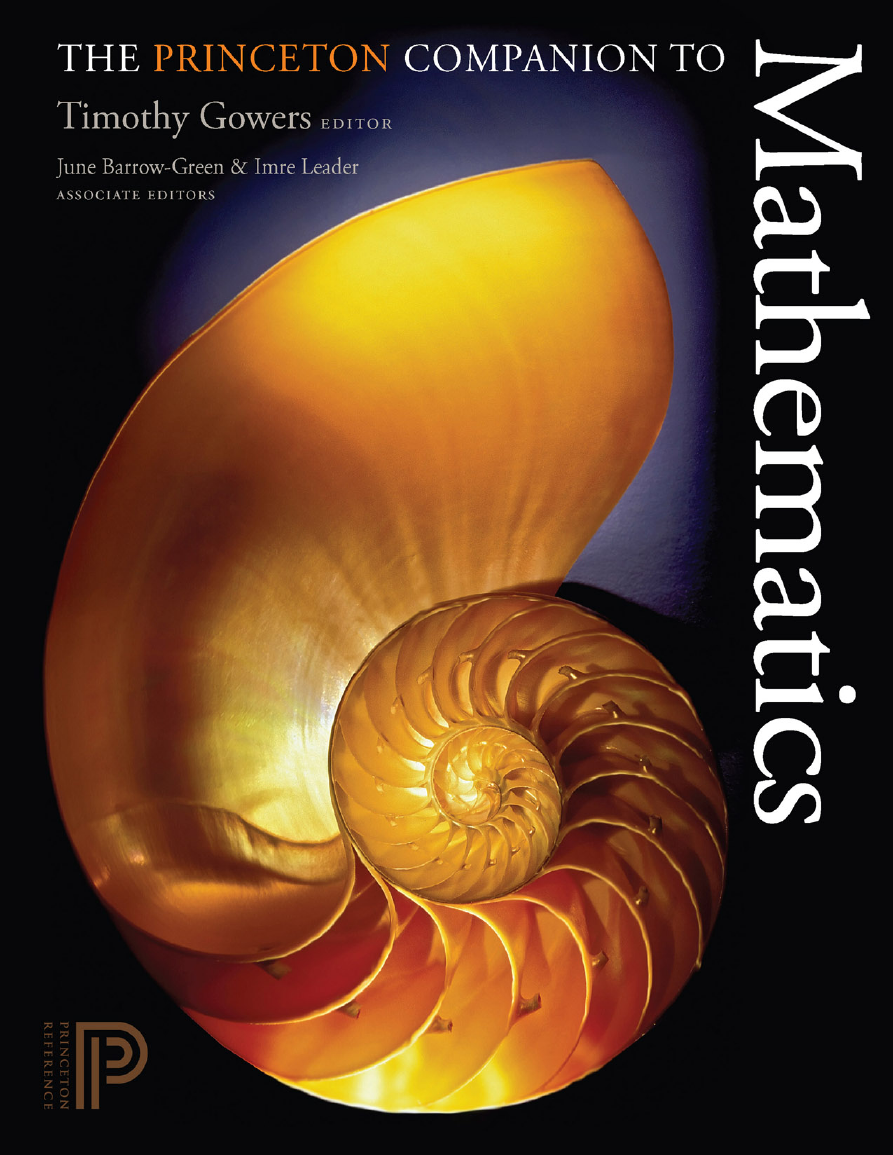
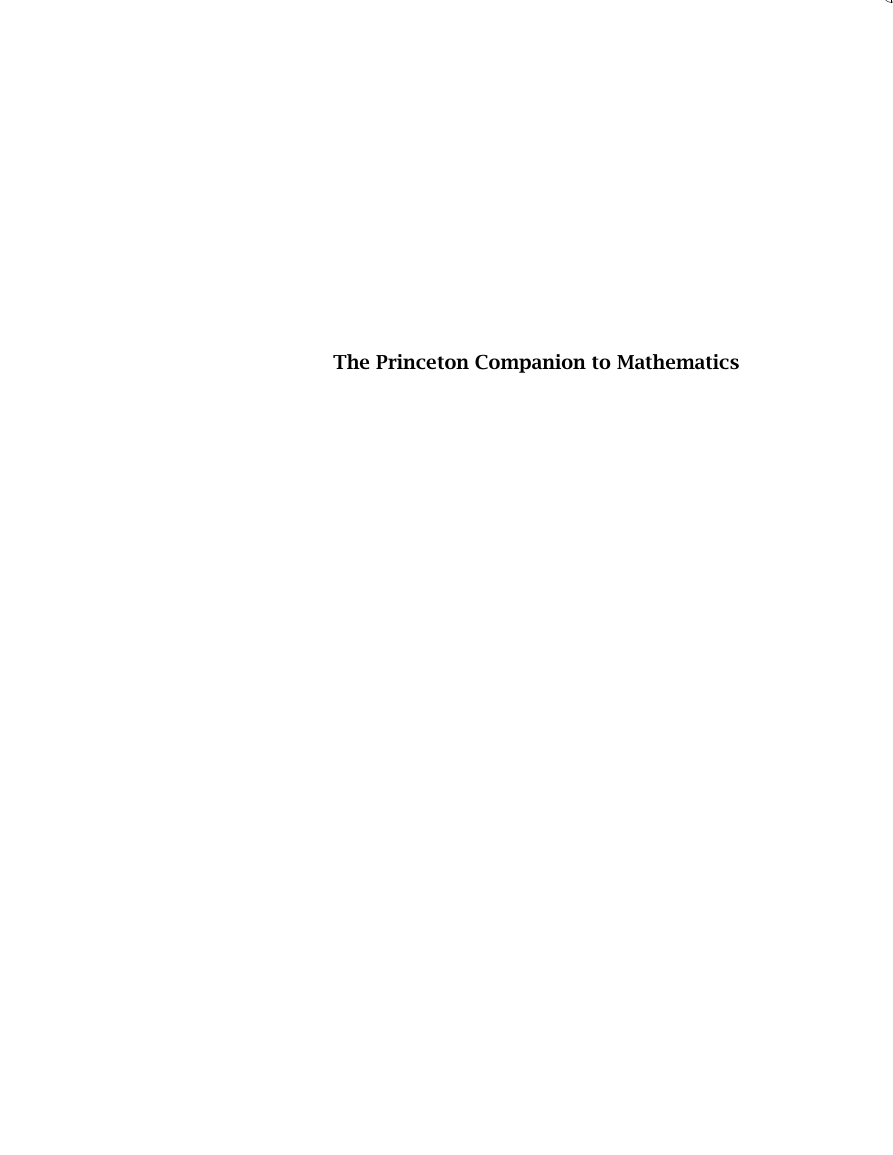

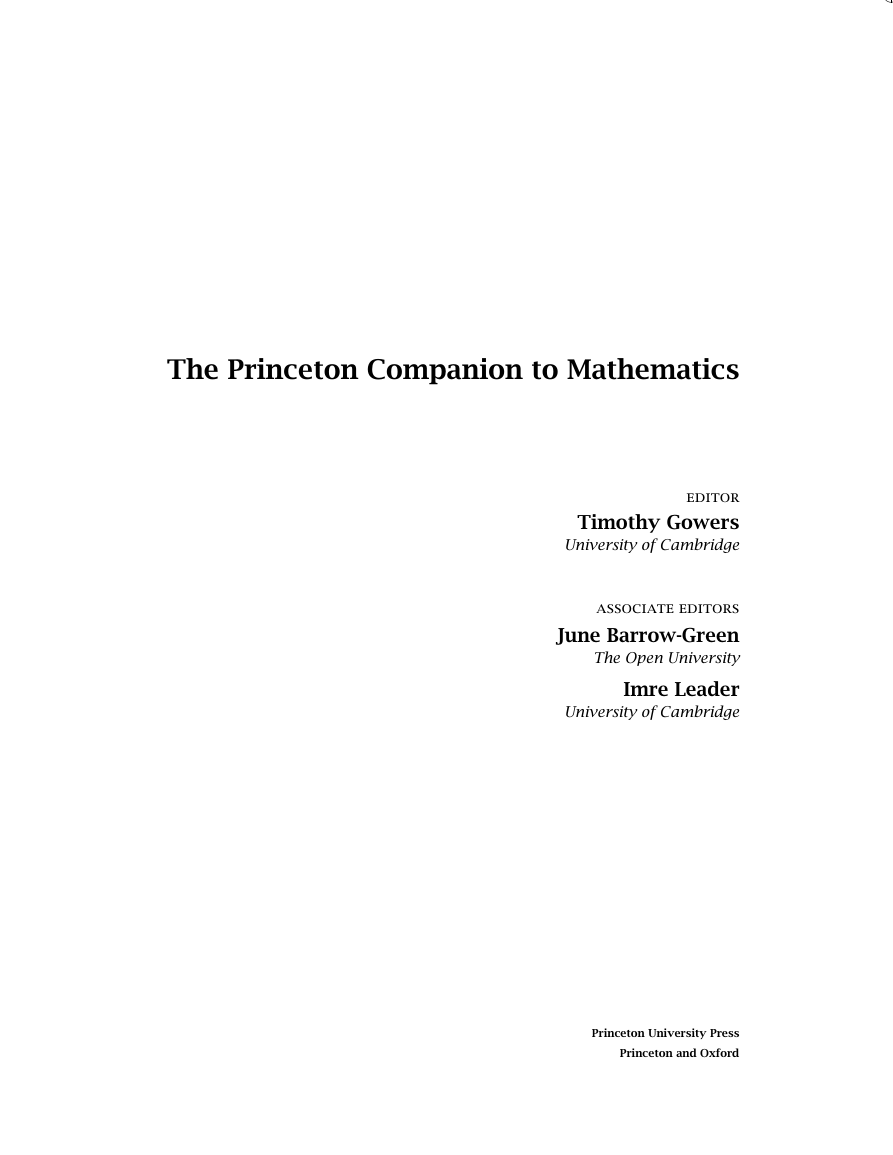
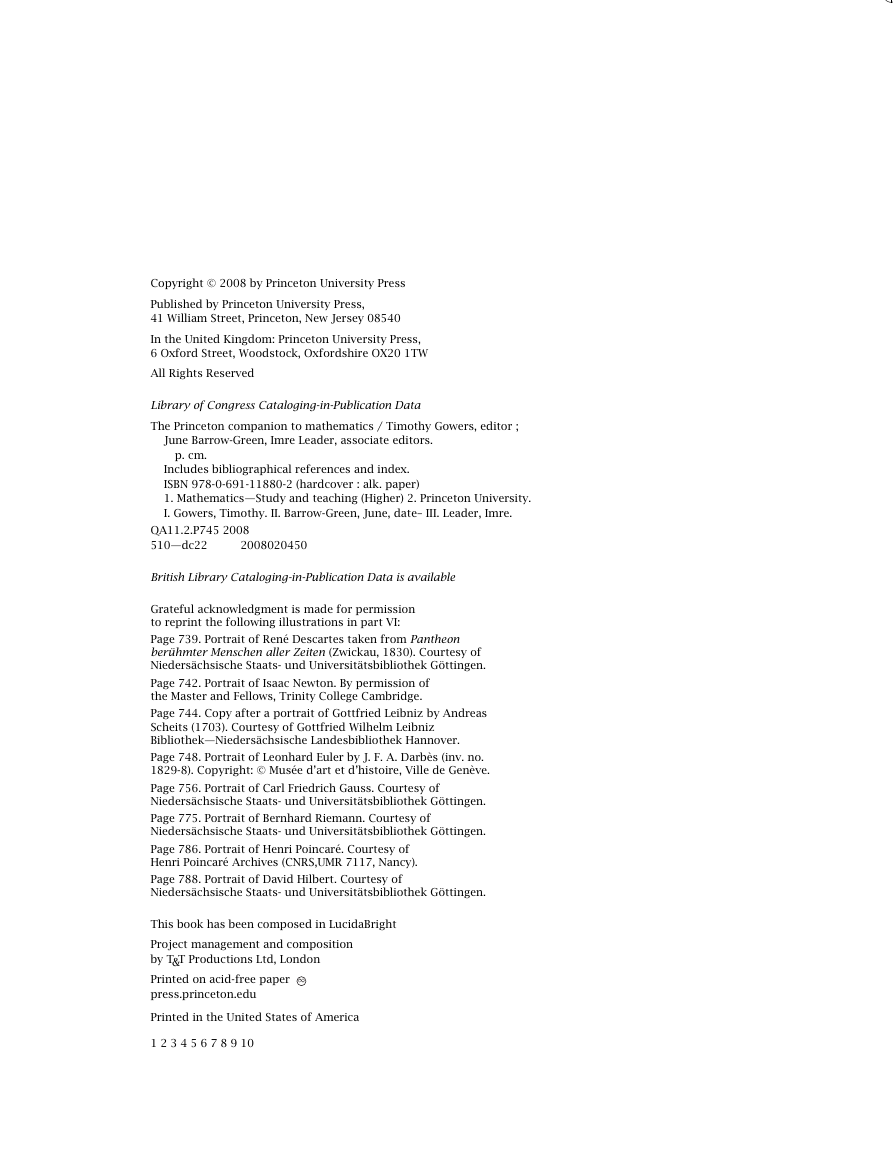
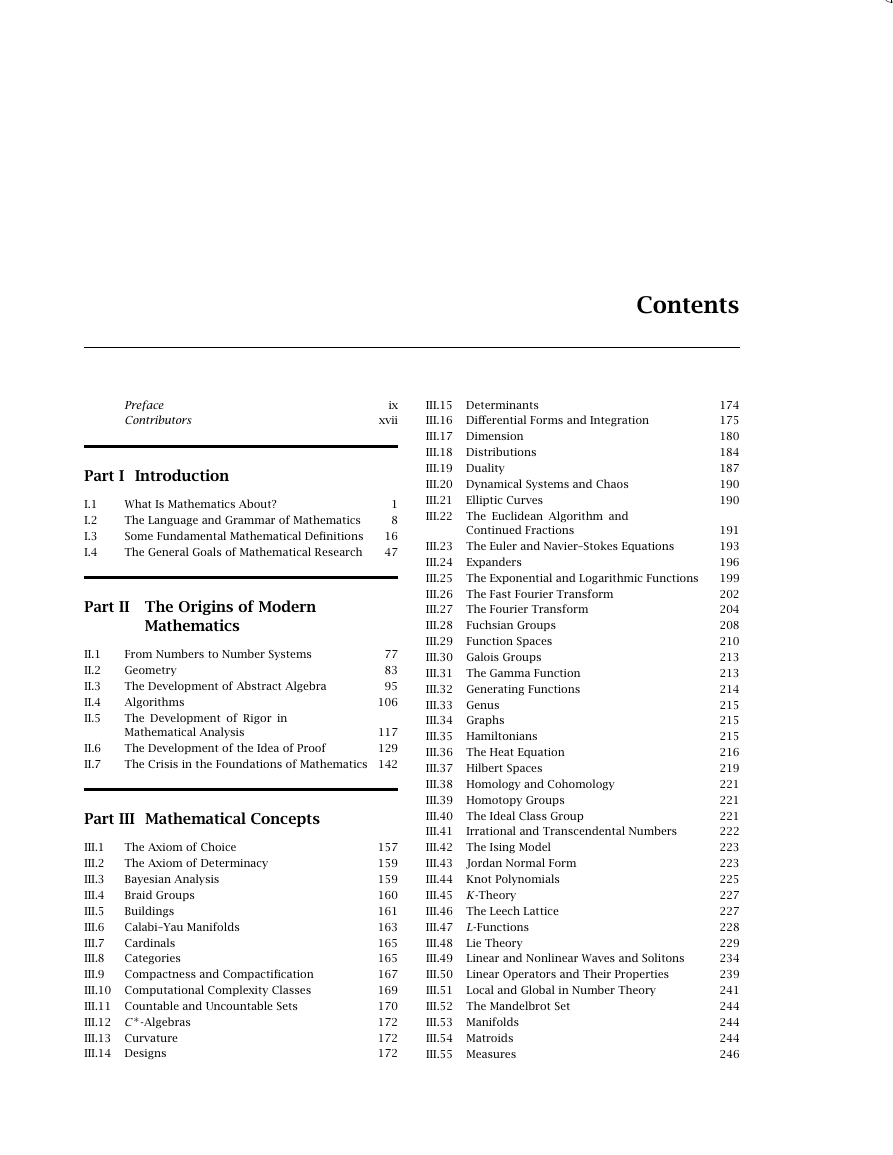

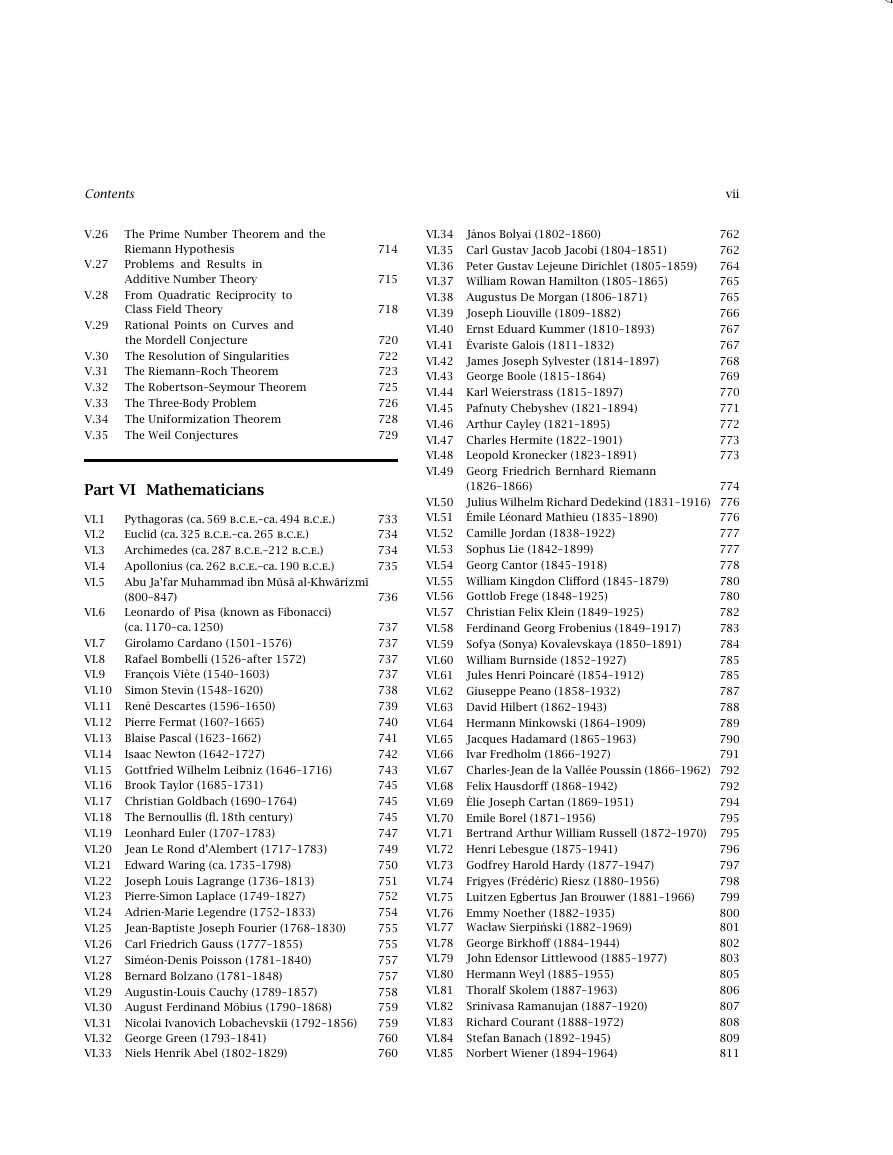








 2023年江西萍乡中考道德与法治真题及答案.doc
2023年江西萍乡中考道德与法治真题及答案.doc 2012年重庆南川中考生物真题及答案.doc
2012年重庆南川中考生物真题及答案.doc 2013年江西师范大学地理学综合及文艺理论基础考研真题.doc
2013年江西师范大学地理学综合及文艺理论基础考研真题.doc 2020年四川甘孜小升初语文真题及答案I卷.doc
2020年四川甘孜小升初语文真题及答案I卷.doc 2020年注册岩土工程师专业基础考试真题及答案.doc
2020年注册岩土工程师专业基础考试真题及答案.doc 2023-2024学年福建省厦门市九年级上学期数学月考试题及答案.doc
2023-2024学年福建省厦门市九年级上学期数学月考试题及答案.doc 2021-2022学年辽宁省沈阳市大东区九年级上学期语文期末试题及答案.doc
2021-2022学年辽宁省沈阳市大东区九年级上学期语文期末试题及答案.doc 2022-2023学年北京东城区初三第一学期物理期末试卷及答案.doc
2022-2023学年北京东城区初三第一学期物理期末试卷及答案.doc 2018上半年江西教师资格初中地理学科知识与教学能力真题及答案.doc
2018上半年江西教师资格初中地理学科知识与教学能力真题及答案.doc 2012年河北国家公务员申论考试真题及答案-省级.doc
2012年河北国家公务员申论考试真题及答案-省级.doc 2020-2021学年江苏省扬州市江都区邵樊片九年级上学期数学第一次质量检测试题及答案.doc
2020-2021学年江苏省扬州市江都区邵樊片九年级上学期数学第一次质量检测试题及答案.doc 2022下半年黑龙江教师资格证中学综合素质真题及答案.doc
2022下半年黑龙江教师资格证中学综合素质真题及答案.doc